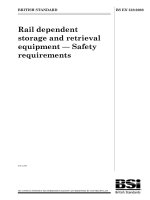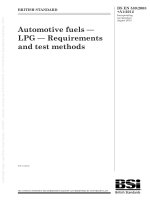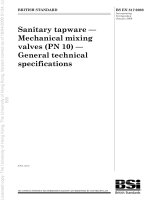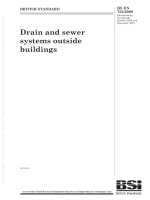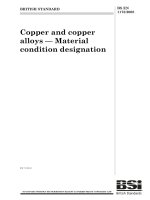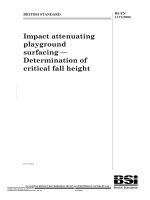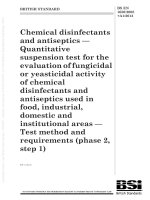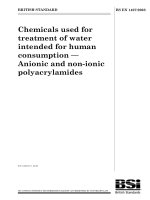Bsi bs en 61230 2008
Bạn đang xem bản rút gọn của tài liệu. Xem và tải ngay bản đầy đủ của tài liệu tại đây (1.68 MB, 66 trang )
BS EN 61230:2008
BSI British Standards
Live working — Portable
equipment for earthing or
earthing and short-circuiting
NO COPYING WITHOUT BSI PERMISSION EXCEPT AS PERMITTED BY COPYRIGHT LAW
raising standards worldwide™
BRITISH STANDARD
BS EN 61230:2008
National foreword
This British Standard is the UK implementation of EN 61230:2008. It is
identical to IEC 61230:2008. It supersedes BS EN 61230:1996 which is
withdrawn.
The UK participation in its preparation was entrusted to Technical Committee
PEL/78, Tools for live working.
A list of organizations represented on this committee can be obtained on
request to its secretary.
This publication does not purport to include all the necessary provisions of a
contract. Users are responsible for its correct application.
© BSI 2009
ISBN 978 0 580 60057 9
ICS 13.260; 29.240.20; 29.260.99
Compliance with a British Standard cannot confer immunity from
legal obligations.
This British Standard was published under the authority of the Standards
Policy and Strategy Committee on31 March 2009
Amendments issued since publication
Amd. No.
Date
Text affected
EUROPEAN STANDARD
EN 61230
NORME EUROPÉENNE
November 2008
EUROPÄISCHE NORM
ICS 13.260; 29.240.20; 29.260.99
Supersedes EN 61230:1995 + A11:1999
English version
Live working Portable equipment for earthing or earthing and short-circuiting
(IEC 61230:2008)
Travaux sous tension Equipements portables de mise à la terre
ou de mise à la terre et en court-circuit
(CEI 61230:2008)
Arbeiten unter Spannung Ortsveränderliche Geräte zum Erden
oder Erden und Kurzschließen
(IEC 61230:2008)
This European Standard was approved by CENELEC on 2008-10-01. CENELEC members are bound to comply
with the CEN/CENELEC Internal Regulations which stipulate the conditions for giving this European Standard
the status of a national standard without any alteration.
Up-to-date lists and bibliographical references concerning such national standards may be obtained on
application to the Central Secretariat or to any CENELEC member.
This European Standard exists in three official versions (English, French, German). A version in any other
language made by translation under the responsibility of a CENELEC member into its own language and notified
to the Central Secretariat has the same status as the official versions.
CENELEC members are the national electrotechnical committees of Austria, Belgium, Bulgaria, Cyprus, the
Czech Republic, Denmark, Estonia, Finland, France, Germany, Greece, Hungary, Iceland, Ireland, Italy, Latvia,
Lithuania, Luxembourg, Malta, the Netherlands, Norway, Poland, Portugal, Romania, Slovakia, Slovenia, Spain,
Sweden, Switzerland and the United Kingdom.
CENELEC
European Committee for Electrotechnical Standardization
Comité Européen de Normalisation Electrotechnique
Europäisches Komitee für Elektrotechnische Normung
Central Secretariat: rue de Stassart 35, B - 1050 Brussels
© 2008 CENELEC -
All rights of exploitation in any form and by any means reserved worldwide for CENELEC members.
Ref. No. EN 61230:2008 E
BS EN 61230:2008
EN 61230:2008
-2-
Foreword
The text of document 78/741/FDIS, future edition 2 of IEC 61230, prepared by IEC TC 78, Live working,
was submitted to the IEC-CENELEC parallel vote and was approved by CENELEC as EN 61230 on
2008-10-01.
This European Standard supersedes EN 61230:1995 + A11:1999.
The major changes are:
– extension of the scope to cover the use of equipment on d.c. installations;
– extension of the use of aluminium to all conductive parts of the device;
– extension of the application to silicone rubber cables made by the revision of TC 20 document
EN 61138;
– possibility of using this standard for separate components of the equipment;
– general revision of requirements and tests;
– deletion of the marking requirement of the double triangle to clarify that the products covered by the
standard are not appropriate for performing live working;
– clarification and modification to the procedure for short-circuit test:
• change of the number of devices submitted to test,
• change of the pre-conditioning time to 48 h,
• clarification of the test procedure for separate components;
– application of conformity assessment for products having completed the production phase, according
to EN 61318:2008;
– revision of existing annexes;
– change of normative Annexes A and C into informative Annexes C and B with a reviewed wording;
– deletion of Annex B, not applicable according to EN 61318:2008;
– deletion of Annex D, its requirements and tests being now included in the body of the standard;
– introduction of a new informative Annex A on railway application;
– introduction of a new informative Annex D giving guidelines for determination of the equivalent r.m.s.
value of a short-circuit current;
– revision of the list of type tests, which now appears in normative Annex E;
– introduction of a new normative Annex F on classification of defects.
The following dates were fixed:
– latest date by which the EN has to be implemented
at national level by publication of an identical
national standard or by endorsement
(dop)
2009-07-01
– latest date by which the national standards conflicting
with the EN have to be withdrawn
(dow)
2011-10-01
Annex ZA has been added by CENELEC.
__________
-3-
EN 61230:2008
Endorsement notice
The text of the International Standard IEC 61230:2008 was approved by CENELEC as a European
Standard without any modification.
In the official version, for Bibliography, the following notes have to be added for the standards indicated:
IEC 60071-1
NOTE Harmonized as EN 60071-1:2006 (not modified).
IEC 60071-2
NOTE Harmonized as EN 60071-2:1997 (not modified).
IEC 60228
NOTE Harmonized as EN 60228:2005 (not modified).
IEC 60743
+ A1
NOTE Harmonized as EN 60743:2001 + A1:2008 (not modified).
IEC 60832
NOTE Harmonized as EN 60832:1996 (modified).
IEC 60855
NOTE Harmonized as EN 60855:1996 (modified).
IEC 60865-1
NOTE Harmonized as EN 60865-1:1993 (not modified).
IEC 60909-0
NOTE Harmonized as EN 60909-0:2001 (not modified).
IEC 61235
NOTE Harmonized as EN 61235:1995 (modified).
IEC 61472
NOTE Harmonized as EN 61472:2004 (not modified).
ISO 9000
NOTE Harmonized as EN ISO 9000:2005 (not modified).
__________
BS EN 61230:2008
EN 61230:2008
-4-
Annex ZA
(normative)
Normative references to international publications
with their corresponding European publications
The following referenced documents are indispensable for the application of this document. For dated
references, only the edition cited applies. For undated references, the latest edition of the referenced
document (including any amendments) applies.
NOTE When an international publication has been modified by common modifications, indicated by (mod), the relevant EN/HD
applies.
Publication
Year
Title
EN/HD
Year
IEC 60060-1
1989
High-voltage test techniques Part 1: General definitions and test
requirements
HD 588.1 S1
1991
IEC 60068-2-11
1981
Environmental testing Part 2: Tests - Test Ka: Salt mist
EN 60068-2-11
1999
IEC 60068-2-42
2003
Environmental testing Part 2-42: Tests - Test Kc: Sulphur dioxide
test for contacts and connections
EN 60068-2-42
2003
IEC 60811-1-4
+ corr. May
+ A1
A2
1985
1986
1993
2001
Common test methods for insulating and
sheathing materials of electric cables Part 1: Methods for general application Section 4: Tests at low temperature
EN 60811-1-4
A2
1995
2001
IEC 60811-2-1
A1
1998
2001
Insulating and sheathing materials of electric EN 60811-2-1
and optical cables - Common test methods - A1
Part 2-1: Methods specific to elastomeric
compounds - Ozone resistance, hot set and
mineral oil immersion tests
1998
2001
IEC 60811-3-1
A1
A2
1985
1994
2001
Common test methods for insulating and
EN 60811-3-1
sheathing materials of electric cables A1
Part 3: Methods specific to PVC compounds - A2
Section 1: Pressure test at high temperature Tests for resistance to cracking
1995
1996
2001
IEC 61138 (mod)
2007
Cables for portable earthing and
short-circuiting equipment
EN 61138
2007
IEC 61318
2007
Live working - Conformity assessment
applicable to tools, devices and equipment
EN 61318
2008
IEC 61477
A1
A2 (mod)
2001
2002
2004
Live working - Minimum requirements for the EN 61477
utilization of tools, devices and equipment
A1
A2
2002
2002
2005
BS EN 61230:2008
–2–
61230 © IEC:2008
CONTENTS
INTRODUCTION.....................................................................................................................7
1
Scope ...............................................................................................................................8
2
Normative references ..................................................................................................... 12
3
Terms and definitions ..................................................................................................... 13
4
Requirements ................................................................................................................. 17
4.1
4.2
4.3
5
General ................................................................................................................. 17
Electrical rating ..................................................................................................... 18
Cables for earthing and short-circuiting ................................................................. 18
4.3.1 Selection of cables .................................................................................... 18
4.3.2 Earthing cables used on solidly earthed (neutral) systems ......................... 19
4.3.3 Earthing cables used on non-solidly earthed (neutral) systems .................. 19
4.4 Short-circuiting bars .............................................................................................. 19
4.5 Connections of cables to rigid parts within devices ................................................ 20
4.6 Clamps .................................................................................................................. 20
4.7 Earthing and short-circuiting device....................................................................... 20
4.8 Basic safety requirements for the insulating element(s) of the insulating
component ............................................................................................................ 21
4.9 Marking ................................................................................................................. 21
4.9.1 General ..................................................................................................... 21
4.9.2 Marking on earthing and short-circuiting device ......................................... 21
4.9.3 Marking on clamp ...................................................................................... 22
4.9.4 Marking on cable ....................................................................................... 22
4.9.5 Marking on other components.................................................................... 22
4.10 Instructions for use................................................................................................ 22
Tests .............................................................................................................................. 23
5.1
5.2
5.3
5.4
5.5
5.6
5.7
General ................................................................................................................. 23
Verification and checking ...................................................................................... 23
Tests for the selection of cables ............................................................................ 24
5.3.1 Cables complying with IEC 61138.............................................................. 24
5.3.2 Cables not complying with IEC 61138 ........................................................ 24
Fatigue and humidity penetration tests on cable with end fittings........................... 24
5.4.1 Fatigue test ............................................................................................... 24
5.4.2 Humidity penetration test ........................................................................... 26
Tension test on cable with end fittings ................................................................... 26
Test on clamps, permanent connection points and connections ............................. 27
5.6.1 Tests for tightening types .......................................................................... 27
5.6.2 Tests for non-tightening types ................................................................... 27
Short-circuit current test ........................................................................................ 27
5.7.1 General ..................................................................................................... 27
5.7.2 Preparation of test pieces .......................................................................... 29
5.7.3 Test set-ups and test arrangements........................................................... 33
5.7.4 Test current, Joule-integral and duration ................................................... 34
5.7.5 Documentation and evaluation of the test .................................................. 35
5.7.6 Alternative means to short-circuit current test for conformity
assessment during production phase ......................................................... 36
BS EN 61230:2008
61230 © IEC:2008
–3–
6
5.8 Durability of marking ............................................................................................. 36
Conformity assessment .................................................................................................. 36
7
Modifications .................................................................................................................. 36
Annex A (informative) Guidelines for portable equipment for earthing to be used on
railway systems .................................................................................................................... 37
Annex B (informative) Guidelines for earthing sticks ............................................................ 41
Annex C (informative) Guidelines for selection, use and maintenance of portable
earthing or earthing and short-circuiting equipment............................................................... 45
Annex D (informative) Guideline for determination of the equivalent r.m.s. value of a
short-time current during a short-circuit of a given duration................................................... 56
Annex E (normative) List of type tests.................................................................................. 58
Annex F (normative) Classification of defects ...................................................................... 59
Bibliography.......................................................................................................................... 60
Figure 1 – Examples of portable equipment and device for installations, network and
railway systems application.....................................................................................................9
Figure 2 – Connection diagrams of single and multi-phase earthing and shortcircuiting devices for network application .............................................................................. 11
Figure 3 – Illustration of a three-phase earthing and short-circuiting device with shortcircuiting bar and earthing cable(s) for installation and network application........................... 12
Figure 4 – Apparatus for fatigue testing with bending and twisting ........................................ 25
Figure 5 – Examples of multiple combinations of clamps accommodating different
shapes and sizes of connection points .................................................................................. 29
Figure 6 – Test set-ups for testing multi-phase devices connected between rigid
conductors for substations .................................................................................................... 31
Figure 7 – Test set-ups for testing multi-phase short-circuiting devices for overhead
lines...................................................................................................................................... 32
Figure 8 – Test set-ups for testing single-phase devices for overhead lines and for
open air substations.............................................................................................................. 33
Figure 9 – Shape of the short-circuit current during test ........................................................ 35
Figure A.1 – Test set-up for testing single phase equipment for railway systems .................. 39
Figure B.1 – Arrangement for bending tests on earthing sticks of circular cross-section ........ 43
Figure B.2 – Arrangement for torsion tests on earthing sticks of circular cross-section.......... 44
Figure C.1 – Curves representing the temperature heating of different nature of
conductors related to the value of the Joule-integral J 2 t........................................................ 49
Figure C.2 – Determination of conductor temperature from heating....................................... 50
Figure C.3 – Determination of J 2 t.......................................................................................... 51
Figure C.4 – Example of the usable region for a device ........................................................ 53
Figure D.1 – Determination of short-time current................................................................... 57
Table 1 – Usual lengths of earthing and short-circuiting cables for different types of
installations and different voltage levels................................................................................ 11
Table 2 – Minimum cross-section of earthing cables related to the cross-section of the
short-circuiting cables and/or bars on non-solidly earthed (neutral) systems ......................... 19
Table 3 – Tension test force on cable with end fittings .......................................................... 27
Table A.1 – Short circuit values for copper cable with a maximum temperature of
450 °C .................................................................................................................................. 40
BS EN 61230:2008
–4–
61230 © IEC:2008
Table B.1 – Maximum deflection ........................................................................................... 43
Table C.1 – Comparison of different standard values of nominal cross-sections.................... 47
Table C.2 – Short-circuit close to generator – Short-circuit current values in kA for
copper cables with a maximum temperature of 300°C ........................................................... 48
Table E.1 – List of type tests referred to subclauses ............................................................. 58
Table F.1 – Classification of defects and associated requirements and tests ........................ 59
BS EN 61230:2008
61230 © IEC:2008
–7–
INTRODUCTION
This International Standard has been prepared in accordance with the requirements of
IEC 61477.
An agreement may be made between manufacturer and customer for additional requirements,
and tests. These additional requirements are prescribed in the customer's specification on the
basis of an acceptance procedure.
BS EN 61230:2008
–8–
61230 © IEC:2008
LIVE WORKING –
PORTABLE EQUIPMENT FOR EARTHING OR
EARTHING AND SHORT-CIRCUITING
1
Scope
This International Standard is applicable to portable equipment, with or without matching
connection points, for temporary earthing or earthing and short-circuiting of electrically
isolated or de-energized a.c. and d.c. installations, distribution and transmission networks,
whether they are overhead or underground or of low or high voltage.
NOTE
Annex A provides guidance for application to railway systems.
This standard covers equipment comprising an earthing or a short-circuiting or an earthing
and short-circuiting device and insulating component. An example is given in Figure 1a and
Figure 1b.
It also covers:
–
earthing or short-circuiting or earthing and short-circuiting devices intended to be installed
with insulating means. An example of an earthing device is given in Figure 1c;
–
separate components, such as conductive extension (see Figure 1b) or clamp or cable
with end fittings.
The performance of equipment, devices and components covered by this standard is based
on electro-dynamic and electro-thermal effects acting during short-circuit. The withstand
capability of the devices and equipment is expressed by their rated values of current, time
and peak factor. No rated voltage is given, but the geometrical dimensions of the equipment
are also linked to the voltage of the installation.
Examples of connection diagrams of earthing and short-circuiting devices are given in
Figures 2 and 3. Associated usual lengths of cables are given in Table 1.
Not covered in this standard are:
–
insulating means, such as insulating sticks, telescopic sticks, insulating handles,
insulating gloves, aerial devices with insulating booms, insulating ropes to be used to
install the earthing and short-circuiting device;
–
insulating components, except for basic safety requirements for the insulating element;
NOTE
Basic safety recommendations for earthing sticks are given in Annex B.
–
devices meant only for the draining of induced currents;
–
relevant working procedures for using portable equipment for earthing or earthing and
short-circuiting.
NOTE The equipment complying with this standard should be used according to safe working procedures and
according to local or national regulation, such as live working or dead working procedures.
BS EN 61230:2008
61230 © IEC:2008
–9–
Figure 1a – Multi-phase equipment
Figure 1b – Single-phase equipment with
extension
Key
1
2
3
4
5
6
7
8
9
10
11
12
13
14
15
16
LI
LH
LO
Earth clamp or rail clamp
Line clamp or contact line clamp
Short-circuiting cable(s)
Earthing cable(s)
Connecting cluster
Earth permanent connection point or rail
Line permanent connection point or
overhead contact line profile
Insulating element
Handle limit mark
Handle of earthing stick
Installation conductor or bar
Earthing system
End cap of stick
End fitting, permanent or detachable
Stick coupling, detachable for transport
reasons
Conductive extension
Length of insulating element
Length of handle
Overall length of earthing stick and
conductive extension component
NOTE 1 The earthing and short-circuiting
device comprises components 1, 2, 3, 4, 5 and
16.
NOTE
The same device can also be used for short-circuiting.
NOTE 2 The
earthing
stick
components 8, 9, 10, 13, 14 and 15.
comprises
NOTE 3 The
earthing
components 1, 2 and 4.
comprises
Figure 1c – Earthing device
Figure 1 – Examples of portable equipment and device
for installations, network and railway systems application
device
BS EN 61230:2008
61230 © IEC:2008
– 10 –
Figure 2b
Figure 2a
Figure 2d
Figure 2c
Key
HVA (Y) = High voltage distribution , Y Neutral system
LV (Δ) = Low voltage, Δ Neutral system
Figure 2e
1
Earth clamp
2
Line clamp
3
Short-circuiting cable(s)
4
Earthing cable(s)
5
Connecting cluster
11
Installation conductor or
bar
16
Conductive extension
BS EN 61230:2008
61230 © IEC:2008
– 11 –
Figure 2f
Figure 2g
Figure 2 – Connection diagrams of single and multi-phase earthing
and short-circuiting devices for network application
NOTE Figure 2 shows examples only of connection arrangements. Not all are suitable for all situations. It is the
responsibility of the user to consider movement of connecting cables from magnetic forces. This has to be
considered prior to a final connection.
Table 1 – Usual lengths of earthing and short-circuiting cables
for different types of installations and different voltage levels
Classes of
operating
voltages
Low voltage
a
Metal enclosed or
indoor substation
Overhead line
Open air substation
Multi-phase
Figures 2a, 2b, 2c, 2d
key 3 = 0,5 m
key 4 = 12 m to 16 m
Multi-phase
Figure 2c ; key 3 = 0,5 m
Figure 2a ; key 3 = 0,5 m and
key 4 = 1 m to 10 m
Specific
Multi-phase
Figures 2a, 2b, 2c
key 3 = 7,5m to 10 m
key 4 = 2,5 m to 3 m
Multi-phase
Figure 2a
key 3 = 0,7 m
key 4 = 2 m
Single-phase
Figure 2f
key 4 = 0,5 m to 10 m
Multi-phase
Figures 2a, 2b, 2c, 2d
key 3 = 2 m to 2,5 m
key 4 = 8 m to 10 m
Multi-phase + 5 m extension
Figure 2g
key 4 = 8 m to 10 m
Distribution a
Single-phase
Figure 2f
key 4 = 8 m to 10 m
Single-phase
Figure 2f
key 4 = 10 m to 12 m
Single-phase
Figure 2f
Single-phase
Figure 2f
key 4 = 10 m to 12 m
Multi-phase
Figure 2a
key 3 = 3 m
key 4 = 3 m
Single-phase +
2 m to 5 m extension
Figure 2g
key 4 = 7 m to 8 m
Single-phase
Figure 2f
key 4 = 3 m to 4 m
key 4 = 8 m
Transmission
a
a
The voltage limits for the different classes of operating voltage are conventional values and could be modified
by national regulations or national practice.
BS EN 61230:2008
– 12 –
61230 © IEC:2008
Key
1
Earth clamp
2
Line clamp
4
Earthing cable(s)
11
Installation conductor
17
Short-circuiting bar
18
Earthing cable connection
Figure 3 – Illustration of a three-phase earthing and short-circuiting device
with short-circuiting bar and earthing cable(s) for installation and network application
2
Normative references
The following referenced documents are indispensable for the application of this document.
For dated references, only the edition cited applies. For undated references, the latest edition
of the referenced document (including any amendments) applies.
IEC 60060-1:1989 High voltage test techniques – Part 1: General definitions and test
requirements 1)
IEC 60068-2-11:1981, Environmental testing – Part 2: Tests – Test Ka: Salt mist
IEC 60068-2-42:2003, Environmental testing – Part 2-42: Tests – Test Kc: Sulphur dioxide
test for contacts and connections
IEC 60811-1-4:1985, Common test methods for insulating and sheathing materials of electric
cables – Part 1: Methods for general application – Section Four: Tests at low temperature
Amendment 1 (1993)
Amendment 2 (2001)
—————————
1) Under revision.
BS EN 61230:2008
61230 © IEC:2008
– 13 –
IEC 60811-2-1:1998, Insulating and sheathing materials of electric and optical cables
Common test methods – Part 2-1: Methods specific to elastomeric compounds – Ozone
resistance, hot test and mineral oil immersion tests
Amendment 1 (2001) 2)
IEC 60811-3-1:1985, Common test methods for insulating and sheathing materials of electric
cables – Part 3: Methods specific to PVC compounds – Section One – Pressure test at high
temperature – Tests for resistance to cracking
Amendment 1 (1994)
Amendment 2 (2001)
IEC 61138:2007, Cables for portable earthing and short-circuiting equipment
IEC 61318:2007, Live working – Conformity assessment applicable to tools, devices and
equipment
IEC 61477:2001, Live working – Minimum requirements for the utilization of tools, devices and
equipment
Amendment 1 (2002)
Amendment 2 (2004) 3)
3
Terms and definitions
For the purposes of this document, the terms and definitions given in IEC 61318 and the
following apply.
NOTE
Further information on terminology is illustrated in Figures 1, 2 and 3.
3.1
conductive extension
rigid conductor forming an extension of an earthing or short-circuiting or earthing and shortcircuiting device
NOTE The conductive extension can be installed between the end fitting of an earthing stick and a line clamp, or
between a line clamp and connecting point.
[IEC 60743, definition 15.9, modified; IEV 651-14-11, modified]
3.2
connecting cluster
component of an earthing and short-circuiting device for connecting short-circuiting cables
either directly or through connecting links, such as cable lugs, to each other and to the
earthing cable(s) and/or the earth clamp
[IEC 60743, definition 15.5, modified; IEV 651-14-06, modified]
3.3
connecting point
part of installation or part of test set-up to which a clamp is connected
—————————
2) There exists a consolidated edition 2.1 (2001) that includes IEC 60811-2-1:1998 and its Amendment 1.
3) There exists a consolidated edition 1.2 (2005) that includes IEC 61447:2001 and its Amendments 1 and 2.
BS EN 61230:2008
– 14 –
61230 © IEC:2008
3.4
connection point
part of installation specially arranged for clamp connection (for example, ball pin, cylinder
bolt, bow, hook, stirrup, stud)
[IEV 651-14-09 modified]
3.5
dead (in live working)
de-energized
at a potential equal to or not significantly different from that of earth at the worksite
NOTE In some countries, according to the dead procedures, the state dead is only considered after the earthing
and short-circuiting equipment has been properly installed.
[IEV 651-01-15 modified]
3.6
earth clamp
clamp forming part of an earthing or earthing and short-circuiting device for connecting an
earthing cable, or a connecting cluster to an earthing conductor or an earth electrode or a
reference potential
[IEC 60743, definition 15.6, modified; IEV 651-14-07, modified]
3.7
earthing and short-circuiting device
assembly of components for interconnecting conductors for earthing or short-circuiting or
earthing and short-circuiting installations and networks
NOTE 1
The earthing and short-circuiting device comprises clamps, cables or bars and possibly clusters.
NOTE 2
The earthing and short-circuiting device could be of single phase type or multi-phase type.
[IEC 60743, definition 15.2, modified; IEV 651-14-03, modified]
3.8
earthing cable
cable forming part of an earthing and short-circuiting device, which connects earth clamp to a
line clamp of the electrical installation or earth clamp to connecting cluster
[IEC 60743, definition 15.1, modified; IEV 651-14-02, modified]
3.9
earthing stick
earth application stick
insulating component equipped with a permanent or detachable end fitting for installing
clamps, short-circuiting bars or conductive extension components onto the electrical
installation
NOTE The insulating element of the earthing stick is intended to provide the adequate safety distance and
insulation to the worker.
[IEC 60743, definition 15.8, modified; IEV 651-14-10, modified]
BS EN 61230:2008
61230 © IEC:2008
– 15 –
3.10
energized (in live working)
at a potential significantly different from that of earth at the worksite and which presents an
electrical hazard
NOTE A part is energized when it is electrically connected to a source of electric energy. It can also be energized
when it is electrically charged under the influence of an electric or magnetic field.
[IEV 651-01-14]
3.11
induced current
electric current resulting from the displacement of charges carriers due to an induced tension
or a magnetic field induction
[IEV 121-11-29 modified]
3.12
insulating element
element of an insulating component that provides adequate electrical insulation to the worker
NOTE For most of the insulating components used in the design of portable equipment for earthing or earthing
and short-circuiting, the insulating element also provides adequate safety distance to the workers.
3.13
insulating component
hand-held insulating part of a portable equipment for earthing or earthing and short-circuiting,
designed to bring and connect clamps to parts of electrical installations
NOTE
An earthing stick is considered as an insulating component.
3.14
insulating means
insulating tool, equipment or device, manual or mechanical, complying with insulating
properties and used for bringing and connecting clamps of earthing and short-circuiting
devices to parts of electrical installations
NOTE An insulating glove, an insulating rope, an insulating handle, an insulating stick, an insulating telescopic
stick, an aerial device with insulating boom, are insulating means.
3.15
insulating stick
insulating tool essentially made of an insulating tube and/or rod with end fittings
[IEV 651-02-01]
3.16
isolate
to disconnect completely a device or circuit from other devices or circuits, separating it
physically, electrically and mechanically from all sources of electrical energy
NOTE
Such separation may not eliminate all effects of electromagnetic or electrostatic induction.
[IEC 61328, definition 3.46, modified; IEC 61911, definition 3.39, modified]
BS EN 61230:2008
– 16 –
61230 © IEC:2008
3.17
line clamp
clamp forming part of an earthing and short-circuiting device, which is attached to a shortcircuiting cable, a short-circuiting bar or conductive extension component, either directly or
through connecting links, and used for the connection to line (line conductors, busbars or
current-carrying conductors), or to the connection point
[IEC 60743, definition 15.7, modified; IEV 651-14-08, modified]
3.18
maintenance test
test carried out periodically on an item to verify that its performance remains within specified
limits, after having made certain adjustments, if necessary
[IEV 151-16-25]
3.19
maximum peak current
ỵ tm
peak value associated with the first major loop of the test short-circuit current determining the
highest electro-dynamic mechanical stresses
3.20
portable equipment for earthing or earthing and short-circuiting
equipment, which is portable and is capable to be carried by one person and manually or
mechanically connected with its insulating component to parts of an electrical installation for
earthing or short-circuiting or earthing and short-circuiting purposes
NOTE 1 The portable equipment for earthing or earthing and short-circuiting comprises the earthing and shortcircuiting device and one or more specific detachable or non-detachable insulating components.
NOTE 2
The use of insulating component is to safely connect the devices to the connecting points.
NOTE 3 The portable equipment for earthing or earthing and short-circuiting is installed temporarily on isolated
power circuits for the purposes of potential equalization and to help protect the worker by conducting a short-circuit
current for a specified duration (time).
NOTE 4 The aim of the earthing and short-circuiting of disconnected or isolated parts of installations is to provide
a control path to the short-circuit current and secondly to prevent the voltage rise in the earth circuit.
[IEV 651-14-01 modified]
3.21
rated current and rated time
r.m.s value of current and time assigned to a device, or component, determining the highest
mechanical and thermal stresses for a given peak factor
NOTE
The values apply only to those parts designed to withstand short-circuit current.
[IEV 651-14-12 modified]
3.22
rated peak factor
ratio of the maximum peak current to its rated current
[IEV 101-14-57 modified]
3.23
safety distance
air clearance between the worker and a live part of the installation related to the voltage of
the installation and to the working procedures, which is determined to prevent any electrical
hazard to occur
BS EN 61230:2008
61230 © IEC:2008
– 17 –
3.24
short-circuiting bar
rigid conductor, such as a bar or tube, forming part of an earthing and short-circuiting device
which connects together phases of the installation
[IEC 60743, definition 15.4, modified; IEV 651-14-05, modified]
3.25
short-circuiting cable
cable forming part of an earthing and short-circuiting device, which connects together clamps
to a common electrical reference point such as a line clamp to another line clamp or to a
connecting cluster
[IEC 60743, definition 15.3, modified; IEV 651-14-04, modified]
3.26
solidly earthed (neutral) system
system whose neutral point(s) is (are) earthed directly
[IEV 601-02-25]
3.27
supplier
organisation or person that provides a product
Example: Producer, distributor, retailer or vendor of a product, or provider of a service or information.
NOTE 1
A supplier can be internal or external to the organisation.
NOTE 2
In a contractual situation a supplier is sometimes called “contractor”.
[ISO 9000, definition 3.3.6]
3.28
transit current
current which flows through the cables of the earthing and short-circuiting device when the
device is completely connected to the electrical installation
NOTE 1 For HV installations or networks, the current may be a residual current (e.g. unbalanced load or induced
current).
NOTE 2 For railway d.c. systems, the current flowing from the rail to the overhead contact line when the earthing
cable is connected and when a train is running on an adjacent rail track.
4
4.1
Requirements
General
The equipment, devices and components shall be designed to contribute to the safety of the
users provided the equipment, devices and components are used by skilled persons, in
accordance with safe methods of work and the instructions for use (see 4.10).
NOTE 1 According to safe procedure, electrical installations are considered energized or live until all protective
earthing and short-circuiting equipment have been properly installed.
NOTE 2 Where applicable, national or regional regulations should be followed, such as live working or dead
working procedures.
Earthing and short-circuiting devices and their components shall be designed to withstand all
the mechanical stresses to which they are submitted during normal use.
BS EN 61230:2008
– 18 –
61230 © IEC:2008
Devices and components shall withstand the maximum short-circuit current, time and Joule
integral for which they are rated.
NOTE
Devices and components should be designed in order to also accept transit current.
Earthing and short-circuiting devices, when installed according to instructions for use, shall be
able to withstand all stresses from short-circuit currents for which they are designed without
causing electrical, mechanical, chemical or thermal danger to persons.
NOTE 1
For indoor use and enclosed space, poisonous effects should be considered (see C.2.2).
NOTE 2
Highest possible temperature rise of cables is therefore adopted to reduce weight.
The manufacturer or the end assembler of all component parts of the equipment shall be
responsible to ensure that the equipment meets all the requirements of this standard.
4.2
Electrical rating
Earthing and short-circuiting devices and their components shall be rated in terms of a shortcircuit current (I r ), a time (t r ) and the corresponding peak factor.
For d.c. applications, the values shall be the same.
Most common values for the rated time are the following:
3 s, 2 s, 1 s, 0,75 s, 0,5 s, 0,25 s, 0,1 s
The rating of the complete device shall be expressed as rated current in kiloamperes, as rated
time in seconds and rated peak factor (see 4.9).
NOTE
In order to compare different rated values see Annex C.
Separate components of the equipment shall be provided with their rated values and their
corresponding test configurations (see 4.10).
Compliance shall be verified by visual verification according to 5.2.
4.3
Cables for earthing and short-circuiting
Earthing and short-circuiting cables, whether they are made of aluminium or aluminium alloy
or made of copper, shall be designed to meet the performance requirement of their rating.
NOTE For selection of the cable cross-section according to temperature rise during a short-circuit, curves or
tables and guidance are given in Annex C.
Cables shall have adequate mechanical, chemical, environmental and electrical properties to
meet all the requirements of this standard.
NOTE 1 It may be acceptable that the insulating covering of the cable may melt or burn according to the
maximum accepted temperature rise during the flow of the short-circuit current and according to the applicable
safety rules.
NOTE 2
4.3.1
Guidance for selection of cables taking into account transit current is given in Annex C.
Selection of cables
Cables for earthing and short-circuiting purposes (see Figures 1, 2, and 3) shall be flexible.
Cables shall be insulated for mechanical protection.
BS EN 61230:2008
61230 © IEC:2008
– 19 –
NOTE The customer may request additional resistance to mechanical shock onto a metallic structure. The cable
with PVC insulation should meet the additional requirement and clashing test of 5.4 of IEC 61138.
The selection of the nature of the insulating material shall be made to fulfil chemical,
environmental and temperature conditions met in practice.
For earthing and short-circuiting cables of a circular cross-section, electrical, mechanical and
other requirements can be met by selecting cables according to IEC 61138.
Cables not complying with IEC 61138 can be used but shall fulfil the following tests:
–
the flexibility shall be in accordance with 5.3 of IEC 61138, and with 8.2 of
IEC 60811-1-4 for low temperature bending test,
–
the physical integrity of the cover shall be in accordance with 5.1.3 of IEC 61138,
–
the type of insulating material shall be in accordance with Clause 7 of IEC 61138,
–
the resistance to mechanical shock shall be in accordance with 4.3.5 of IEC 61138.
Compliance for selection shall be verified by visual verification of the conformity to IEC 61138
or shall be verified by tests according to 5.3.2.
4.3.2
Earthing cables used on solidly earthed (neutral) systems
Earthing cables used on solidly earthed systems shall have the same cross-section as the
associated short-circuiting cables or bars.
4.3.3
Earthing cables used on non-solidly earthed (neutral) systems
Earthing cables used on non-solidly earthed systems may have a cross-section less than the
corresponding short-circuiting cables or bars, but never less than that given in Table 2. For
values in between those listed in the first column, the value of the second column shall be the
next higher size.
Table 2 – Minimum cross-section of earthing cables related to the cross-section of the
short-circuiting cables and/or bars on non-solidly earthed (neutral) systems
4.4
Copper equivalent cross-section of
short-circuiting cables and/or bars
mm 2
Minimum copper equivalent
cross-section of earthing cables
mm 2
16
16
25
16
35
16
50
25
70
35
95
35
120
50
150
50
Short-circuiting bars
Short-circuiting bars, whether they are made of aluminium or aluminium alloy or made of
copper, shall be designed to meet the performance requirement of their rating.
They shall be designed to be compatible with the installation on which they may be
positioned. For this purpose, dimensions of short-circuiting bars are not standardised.
Compliance shall be verified by manual checking according to 5.2 and by test according to
5.7.
BS EN 61230:2008
– 20 –
4.5
61230 © IEC:2008
Connections of cables to rigid parts within devices
Excellent fatigue resistance is required for the connections of cables to rigid parts (ferrules,
cable lugs, end fittings, clusters, etc.).
The connections shall be made with great care to ensure that the specified minimum
characteristics of the cables are maintained. Soldered connections are not permitted.
The connection between end fittings and cables shall be protected from water penetration.
All attachments shall be protected against unintentional loosening. Single screws or nuts, if
used, shall always be combined with a device, for instance lock washers, that positively
prevents slippage or rotation.
Ferrules, cable lugs, end fittings, etc., shall have at least a current-carrying capacity
equivalent to the associated cables.
Compliance shall be verified by visual verification according to 5.2 and by tests according to
5.4, 5.5 and 5.7.
4.6
Clamps
Clamps shall be designed to withstand the stresses for which they are rated. They shall
provide reliable contact performance and shall withstand the thermal and mechanical stresses
produced by the rated short-circuit currents.
Line and earth clamps shall be suitable for the surface and shape of the connecting point and
shall permit easy and safe installation without causing damage to clamps and without danger
for personnel.
For tightening type, the manufacturer or the end assembler shall provide a rated torque which
shall be properly defined for the installation.
For other types such as spring clamps they shall not require an unusual force during the
positioning and the removing operations.
NOTE More than one spring clamp may be put on the top end of an earthing stick for a quick and multiple
operation. For this reason it is allowed to have specific or additional positioning device for holding many clamps.
Each different design of clamp of the same rating shall be type tested in the same conditions
in order to be considered equivalent.
Compliance shall be verified by manual checking according to 5.2 and by tests according to
5.6 and 5.7.
4.7
Earthing and short-circuiting device
The different components of an earthing and short-circuiting device may come from the same
manufacturer or from different manufacturers. The final assembly shall be made under the
responsibility of the manufacturer or the end assembler of the device. Manufacturer or
supplier of separate components shall give sufficient information in order to maintain the
capability of the complete device. The final quality of the device after assembly relies only on
its end assembler.
A earthing and short-circuiting device can use cables in parallel as short-circuiting or earthing
cables.
BS EN 61230:2008
61230 © IEC:2008
– 21 –
For a multi-phase earthing and short-circuiting device, all cables exposed to a rated shortcircuit current shall have the same cross-section, but the earthing cable(s) may have a
smaller cross-section in case of use on non-solidly earthed system (see Table 2).
Compliance shall be verified by verification and checking according to 5.2 and by test
according to 5.7.
4.8 Basic safety requirements for the insulating element(s) of the insulating
component
The insulating elements(s) of the insulating component (earthing stick or other type) shall
make use of insulating material(s) and shall be designed such as to provide basic electrical
insulating properties to permit the workers to establish the appropriate electrical insulation
when installing and removing the portable equipment for earthing or earthing and shortcircuiting.
The manufacturer shall identify the design parameters associated with the basic insulating
properties of the insulating element.
NOTE 1 Many parameters of a design of insulating element influence its overall insulating performance. Some
parameters are under the control of the manufacturer. Others (ex: the length of insulating tube or rod) may be
influenced by working procedures, regional or national regulations. The basic insulating properties are here
associated with the design parameters controlled by the manufacturer.
NOTE 2 For example, when cylindrical tubes or rods are used as raw material for the design of the insulating
element of an earthing stick, a design parameter associated with the basic electrical properties is the appropriate
selection of tubes or rods according to IEC 60855 or IEC 61235.
Annex B provides guidance for selection of the insulating element of the earthing stick as a
type of insulating component of complete equipment.
Compliance to the basic safety requirements shall be verified by verification according to 5.2.
4.9
Marking
4.9.1
General
The marking shall be clearly legible. It shall be durable and not removable.
Each device, cable and clamp shall be marked properly.
When a device is made of several components of different rating, the marking of the rated
values of the device shall be the minimum of the rated capacity of each component and under
the responsibility of the final assembler.
NOTE
Additional recommendations are given in Annexes B and C.
Compliance shall be verified by visual verification according to 5.2 and by test according to
5.8.
4.9.2
Marking on earthing and short-circuiting device
The device itself or an additional non-removable label shall be marked where appropriate with
at least the following items of marking:
–
manufacturer's name or trade mark or end assembler's name;
–
model or type reference for the device;
–
year of manufacture;
BS EN 61230:2008
– 22 –
61230 © IEC:2008
–
rated current I r (kA), rated time t r (s) of the device and value of the rated peak factor (for
example 10 kA – 0,5 s – 2,6);
–
number of the relevant IEC standard.
4.9.3
Marking on clamp
Clamp itself or an additional non-removable label shall be marked with at least the following
items of marking:
–
manufacturer's name or trademark;
–
model or type reference for the clamp.
4.9.4
Marking on cable
For cables covered by IEC 61138, no other marking is required.
NOTE
The reference number of the cable standard is given by the code designation.
For cables not covered by IEC 61138, the cable shall be marked with the following items:
–
indication of the origin of the cable (see 4.4.1 of IEC 61138);
–
cross-section or cable size;
–
nature of the insulating covering (see Clause 7 of IEC 61138).
4.9.5
Marking on other components
Other components such as short-circuiting bars or conductive extension of the earthing and
short-circuiting devices may be delivered separately. In that case they shall be marked similar
to the clamps.
4.10
Instructions for use
Each device or equipment covered by this standard shall be supplied with manufacturer’s
written information and instructions for use and care. These instructions shall be prepared in
accordance with the general provisions given in IEC 61477.
They shall include at least the following:
–
instructions for assembling the complete device or equipment;
–
limitation, if any, of the main characteristics such as rated values, temperature conditions,
indoor use, etc.;
–
rated values (current, time and peak factor) of the separate components;
–
guidelines for maintenance, use, storage and inspection;
NOTE
Users should also refer to Annex C for additional information.
–
torque and force values and instructions for securing of auxiliary fasteners, which may
loosen during use;
–
information about the use of aluminium for cables, clamps and other parts of the devices,
if relevant;
–
statement that “the devices shall be removed from service after exposure to short-circuit
current” (see C.4);
–
number of the relevant IEC standard and the year of publication with amendment, if any.
NOTE
Additional instructions for use may be requested by the customer.
Compliance shall be checked by visual verification according to 5.2.

